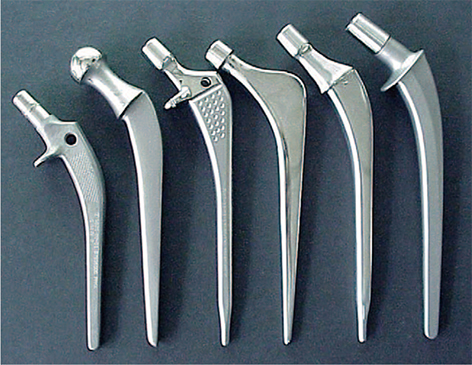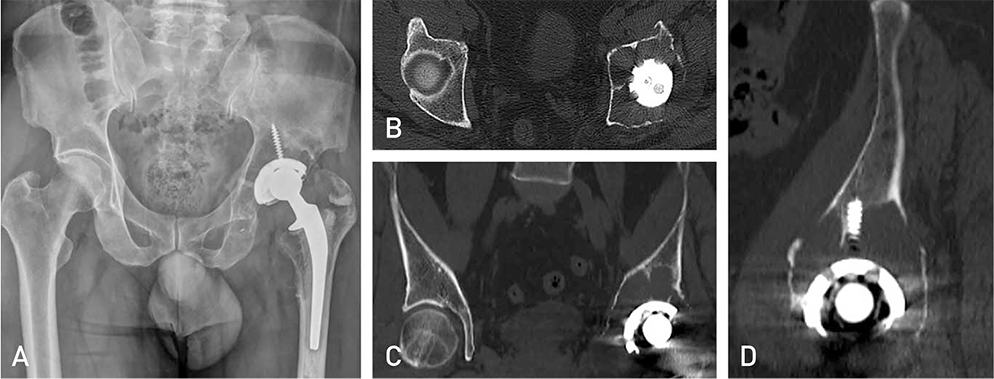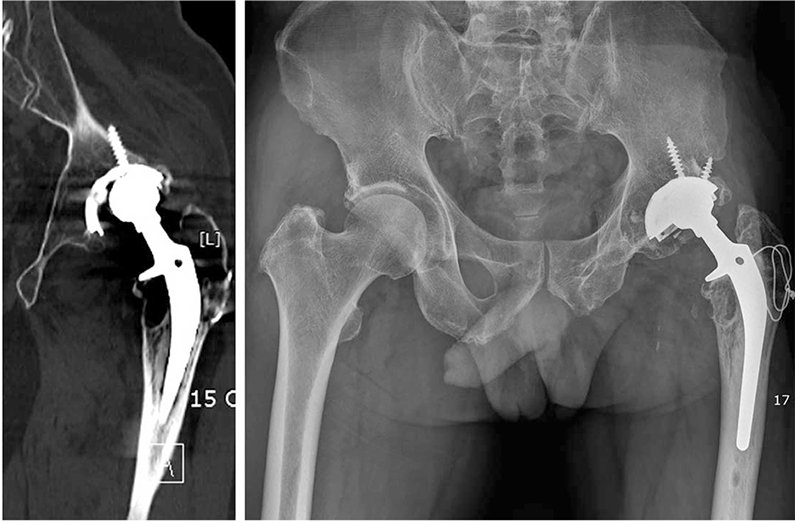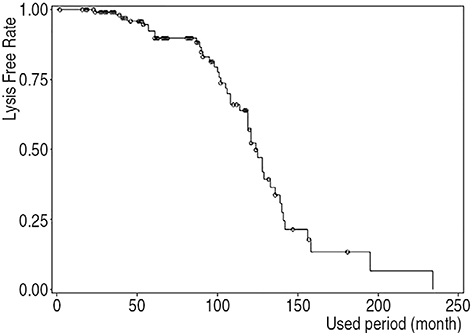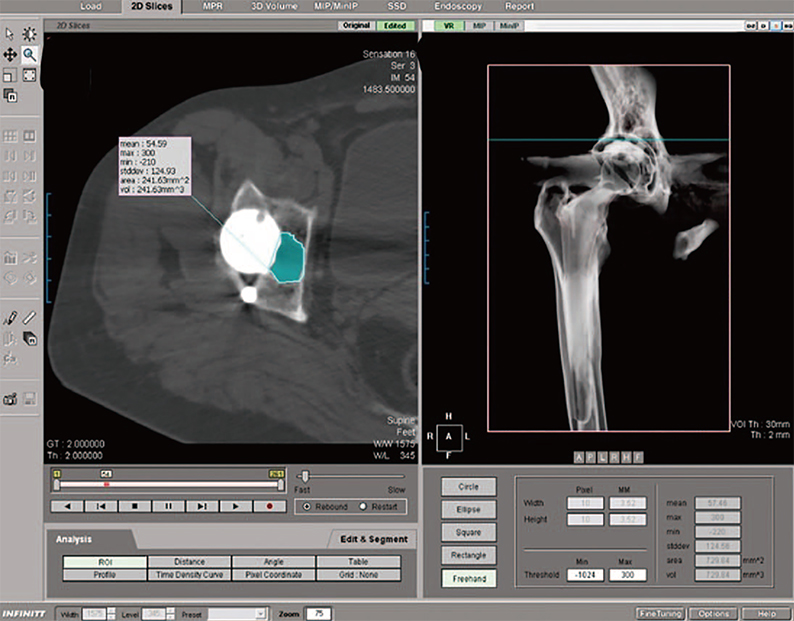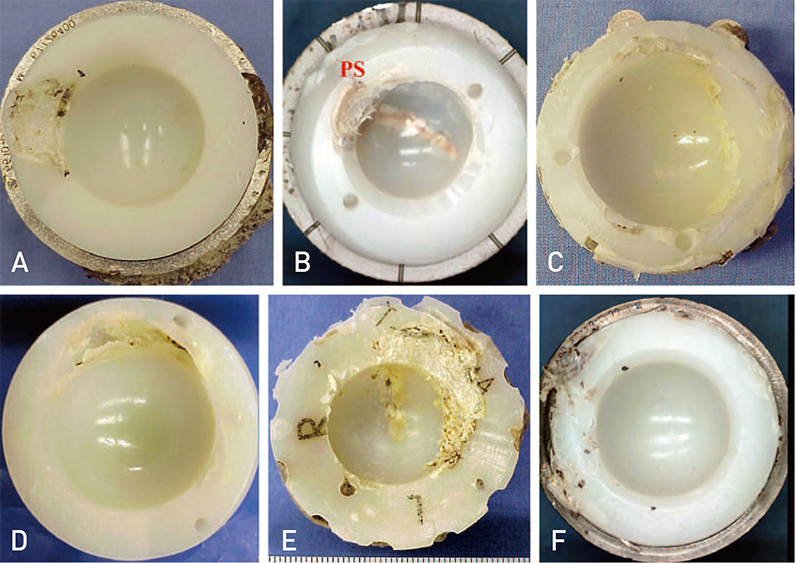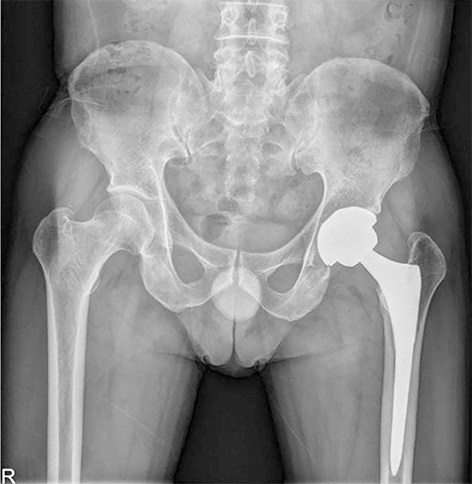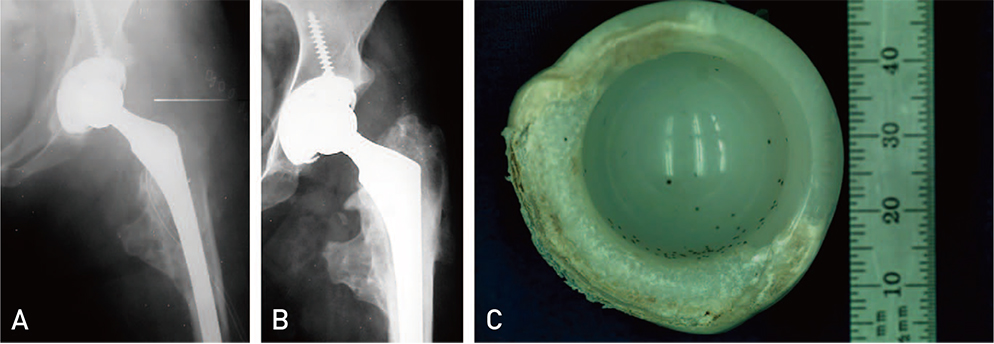Hip Pelvis.
2019 Dec;31(4):179-189. 10.5371/hp.2019.31.4.179.
Total Hip Arthroplasty: Past, Present, and Future. What Has Been Achieved?
- Affiliations
-
- 1Department of Orthopedic Surgery, Bumin Hospital, Busan, Korea.
- 2Department of Orthopedic Surgery, Veterans Health Service Medical Center, Seoul, Korea. 3188yun@naver.com
- KMID: 2464234
- DOI: http://doi.org/10.5371/hp.2019.31.4.179
Abstract
- In the 1960s, Sir John Charnley introduced to clinical practice his concept of low-friction total hip arthroplasty (THA). Although early designs were plagued by poor performance and even failure, there have been steady advances in implant designs, biomaterials, surgical techniques and an understanding of the biomechanical restoration of the hip; these advances have contributed to improvements in implant survival and clinical outcomes of THA in the past three decades. With improved wear resistance and mechanical reliability, a potential to last for at least 25 to 30 years are now available for THA. In this review, we focus on the evolution of THA and review current controversies and future directions of this procedure based on a single surgeon's 29-year of experience at a single institution.
Figure
Reference
-
1. Law WA. Post-operative study of vitallium mould arthroplasty of the hip joint. J Bone Joint Surg Br. 1948; 30B:76–83.
Article2. Smith-Petersen MN. Evolution of mould arthroplasty of the hip joint. J Bone Joint Surg Br. 1948; 30B:59–75.
Article3. Charnley J. Anchorage of the femoral head prosthesis to the shaft of the femur. J Bone Joint Surg Br. 1960; 42:28–30.
Article4. Charnley J. Arthroplasty of the hip. A new operation. Lancet. 1961; 1:1129–1132.
Article5. Amstutz HC, Campbell P, Kossovsky N, Clarke IC. Mechanism and clinical significance of wear debris-induced osteolysis. Clin Orthop Relat Res. 1992; (276):7–18.
Article6. Chandler HP, Reineck FT, Wixson RL, McCarthy JC. Total hip replacement in patients younger than thirty years old. A five-year follow-up study. J Bone Joint Surg Am. 1981; 63:1426–1434.
Article7. Collis DK. Cemented total hip replacement in patients who are less than fifty years old. J Bone Joint Surg Am. 1984; 66:353–359.
Article8. Cooper RA, McAllister CM, Borden LS, Bauer TW. Polyethylene debris-induced osteolysis and loosening in uncemented total hip arthroplasty. A cause of late failure. J Arthroplasty. 1992; 7:285–290.
Article9. Goetz DD, Smith EJ, Harris WH. The prevalence of femoral osteolysis associated with components inserted with or without cement in total hip replacements. A retrospective matched-pair series. J Bone Joint Surg Am. 1994; 76:1121–1129.
Article10. Gruen TA, McNeice GM, Amstutz HC. “Modes of failure” of cemented stem-type femoral components: a radiographic analysis of loosening. Clin Orthop Relat Res. 1979; (141):17–27.11. Phillips FM, Pottenger LA, Finn HA, Vandermolen J. Cementless total hip arthroplasty in patients with steroid-induced avascular necrosis of the hip A 62-month follow-up study. Clin Orthop Relat Res. 1994; (303):147–154.12. Salvati EA, Cornell CN. Long-term follow-up of total hip replacement in patients with avascular necrosis. Instr Course Lect. 1988; 37:67–73.13. Reese A, Macaulay W. Hybrid total hip arthroplasty: stateof-the-art in the new millennium? J South Orthop Assoc. 2003; 12:75–78.14. Suh DH, Yun HH, Chun SK, Shon WY. Fifteen-year results of precoated femoral stem in primary hybrid total hip arthroplasty. Clin Orthop Surg. 2013; 5:110–117.
Article15. Smith SE, Estok DM 2nd, Harris WH. Average 12-year outcome of a chrome-cobalt, beaded, bony ingrowth acetabular component. J Arthroplasty. 1998; 13:50–60.
Article16. Kim YH, Kim JS, Cho SH. Primary total hip arthroplasty with a cementless porous-coated anatomic total hip prosthesis: 10- to 12-year results of prospective and consecutive series. J Arthroplasty. 1999; 14:538–548.
Article17. Clohisy JC, Harris WH. The Harris-Galante porous-coated acetabular component with screw fixation. An average tenyear follow-up study. J Bone Joint Surg Am. 1999; 81:66–73.
Article18. Maloney WJ, Galante JO, Anderson M, et al. Fixation, polyethylene wear, and pelvic osteolysis in primary total hip replacement. Clin Orthop Relat Res. 1999; (369):157–164.
Article19. Ong A, Wong KL, Lai M, Garino JP, Steinberg ME. Early failure of precoated femoral components in primary total hip arthroplasty. J Bone Joint Surg Am. 2002; 84:786–792.
Article20. Charnley J. Total hip replacement by low-friction arthroplasty. Clin Orthop Relat Res. 1970; 72:7–21.
Article21. Sochart DH, Porter ML. The long-term results of Charnley low-friction arthroplasty in young patients who have congenital dislocation, degenerative osteoarthrosis, or rheumatoid arthritis. J Bone Joint Surg Am. 1997; 79:1599–1617.
Article22. Jones LC, Hungerford DS. Cement disease. Clin Orthop Relat Res. 1987; (225):192–206.
Article23. Chen FS, Di Cesare PE, Kale AA, et al. Results of cemented metal-backed acetabular components: a 10-year-average follow-up study. J Arthroplasty. 1998; 13:867–873.24. Clarke IC, Good V, Anissian L, Gustafson A. Charnley wear model for validation of hip simulators--ball diameter versus polytetrafluoroethylene and polyethylene wear. Proc Inst Mech Eng H. 1997; 211:25–36.
Article25. Parks ML, Walsh HA, Salvati EA, Li S. Effect of increasing temperature on the properties of four bone cements. Clin Orthop Relat Res. 1998; (355):238–248.
Article26. Yun HH, Shon WY, Yoon JR, Yang JH, Lim DS. Reliability of a PowerPoint method for wear measurement after total hip arthroplasty: a retrieval study using 3-dimensional laser scanning. J Arthroplasty. 2012; 27:1530–1537.
Article27. Yun HH, Shon WY, Hong SJ, Yoon JR, Yang JH. Relationship between the pelvic osteolytic volume on computed tomography and clinical outcome in patients with cementless acetabular components. Int Orthop. 2011; 35:1453–1459.
Article28. Yun HH, Jajodia NK, Myung JS, Oh JK, Park SW, Shon WY. Use of slide presentation software as a tool to measure hip arthroplasty wear. J Arthroplasty. 2009; 24:1210–1215.
Article29. Shon WY, Gupta S, Biswal S, Han SH, Hong SJ, Moon JG. Pelvic osteolysis relationship to radiographs and polyethylene wear. J Arthroplasty. 2009; 24:743–750.
Article30. Suh DH, Han SB, Yun HH, Chun SK, Shon WY. Characterization of progression of pelvic osteolysis after cementless total hip arthroplasty: computed tomographic study. J Arthroplasty. 2013; 28:1851–1855.
Article31. Yi JW, Shon WY, Huh CY, Yun HH, Huh YJ. Follow-up study of the cemented polished femoral stem for more than five years. J Korean Hip Soc. 2011; 23:25–31.
Article32. McKellop H, Shen FW, Lu B, Campbell P, Salovey R. Development of an extremely wear-resistant ultra high molecular weight polyethylene for total hip replacements. J Orthop Res. 1999; 17:157–167.
Article33. Wroblewski BM, Siney PD, Fleming PA. Low-friction arthroplasty of the hip using alumina ceramic and cross-linked polyethylene. A 17-year follow-up report. J Bone Joint Surg Br. 2005; 87:1220–1221.34. Shon WY, Baldini T, Peterson MG, Wright TM, Salvati EA. Impingement in total hip arthroplasty a study of retrieved acetabular components. J Arthroplasty. 2005; 20:427–435.35. Firkins PJ, Tipper JL, Ingham E, Stone MH, Farrar R, Fisher J. A novel low wearing differential hardness, ceramic-on-metal hip joint prosthesis. J Biomech. 2001; 34:1291–1298.
Article36. Williams S, Schepers A, Isaac G, et al. The 2007 Otto Aufranc Award. Ceramic-on-metal hip arthroplasties: a comparative in vitro and in vivo study. Clin Orthop Relat Res. 2007; 465:23–32.37. Bisschop R, Boomsma MF, Van Raay JJ, Tiebosch AT, Maas M, Gerritsma CL. High prevalence of pseudotumors in patients with a Birmingham Hip Resurfacing prosthesis: a prospective cohort study of one hundred and twenty-nine patients. J Bone Joint Surg Am. 2013; 95:1554–1560.
Article38. Bozic KJ, Browne J, Dangles CJ, et al. Modern metal-on-metal hip implants. J Am Acad Orthop Surg. 2012; 20:402–406.
Article39. Han SB, Oh JK, Jang WY, Choudhary N, Kim HG, Shon WY. Increased serum ion levels after ceramic-on-metal bearing total hip arthroplasty: influence of an Asian lifestyle. J Arthroplasty. 2018; 33:887–892.
Article40. Naik LG, Shon WY, Clarke IC, Moon JG, Mukund P, Kim SM. Pseudotumor and subsequent implant loosening as a complication of revision total hip arthroplasty with ceramic-on-metal bearing: a case report. Hip Pelvis. 2018; 30:276–281.
Article41. Pearson MJ, Grover LM, Lord JM, Jones SW, Davis ET. Bearings in hip arthroplasty: joint registries vs precision medicine: review article. HSS J. 2017; 13:20–27.42. Kasina P, Wall A, Lapidus LJ, et al. Postoperative thromboprophylaxis with new oral anticoagulants is superior to LMWH in hip arthroplasty surgery: findings from the Swedish registry. Clin Orthop Relat Res. 2019; 477:1335–1343.
Article43. Heckmann ND, Sivasundaram L, Stefl MD, Kang HP, Basler ET, Lieberman JR. Total hip arthroplasty bearing surface trends in the United States from 2007 to 2014: the rise of ceramic on polyethylene. J Arthroplasty. 2018; 33:1757–1763.e1.
Article44. Rajaee SS, Theriault RV, Pevear ME, Smith EL. National trends in primary total hip arthroplasty in extremely young patients: a focus on bearing surface usage from 2009 to 2012. J Arthroplasty. 2016; 31:9 Suppl. 63–68.
Article45. Fawsitt CG, Thom HHZ, Hunt LP, et al. Choice of prosthetic implant combinations in total hip replacement: cost-effectiveness analysis using UK and Swedish hip joint registries data. Value Health. 2019; 22:303–312.
Article46. Yoon PW, Yoo JJ, Kim Y, Yoo S, Lee S, Kim HJ. The epidemiology and national trends of bearing surface usage in primary total hip arthroplasty in Korea. Clin Orthop Surg. 2016; 8:29–37.
Article47. Rivière C, Harman C, Parsons T, Villet L, Cobb J, Maillot C. Kinematic alignment versus conventional techniques for total hip arthroplasty: a retrospective case control study. Orthop Traumatol Surg Res. 2019; 105:895–905.
Article48. Komiyama K, Hamai S, Hara D, et al. Dynamic hip kinematics during squatting before and after total hip arthroplasty. J Orthop Surg Res. 2018; 13:162.
Article49. Lum ZC, Coury JG, Cohen JL, Dorr LD. The current knowledge on spinopelvic mobility. J Arthroplasty. 2018; 33:291–296.
Article50. Stefl M, Lundergan W, Heckmann N, et al. Spinopelvic mobility and acetabular component position for total hip arthroplasty. Bone Joint J. 2017; 99:1 Supple A. 37–45.
Article51. Shon WY, Sharma V, Keon OJ, Moon JG, Suh DH. Can pelvic tilting be ignored in total hip arthroplasty? Int J Surg Case Rep. 2014; 5:633–636.
Article52. Shon WY, Gupta S, Biswal S, et al. Validation of a simple radiographic method to determine variations in pelvic and acetabular cup sagittal plane alignment after total hip arthroplasty. Skeletal Radiol. 2008; 37:1119–1127.
Article53. Lazennec JY, Charlot N, Gorin M, et al. Hip-spine relationship: a radio-anatomical study for optimization in acetabular cup positioning. Surg Radiol Anat. 2004; 26:136–144.
Article54. Tang H, Du H, Tang Q, Yang D, Shao H, Zhou Y. Chinese patients’ satisfaction with total hip arthroplasty: what is important and dissatisfactory? J Arthroplasty. 2014; 29:2245–2250.
Article55. Fujita K, Kang HS, Mawatari M, Makimoto K, Lee M, Hwang J. Quality of life, effects on Asian lifestyle, and perceived satisfaction after total hip arthroplasty in Japan and Korea. Int J Orthop Trauma Nurs. 2018; 31:20–25.
Article56. Fujita K, Xia Z, Liu X, Mawatari M, Makimoto K. Lifestyle and health-related quality of life in Asian patients with total hip arthroplasties. Nurs Health Sci. 2014; 16:365–372.
Article
- Full Text Links
- Actions
-
Cited
- CITED
-
- Close
- Share
- Similar articles
-
- The Scientic Basis and Problem in Total Hip Replacement
- The History of Total Hip Arthroplasty
- History of the Artificial Hip Joint
- Modified Posterior Approach to Total Hip Arthroplasty
- Total Hip Replacement Arthroplasty in Patient with Idiopathic Thrombocytopenic Purpura: Clinical Experience of Perioperative Management

